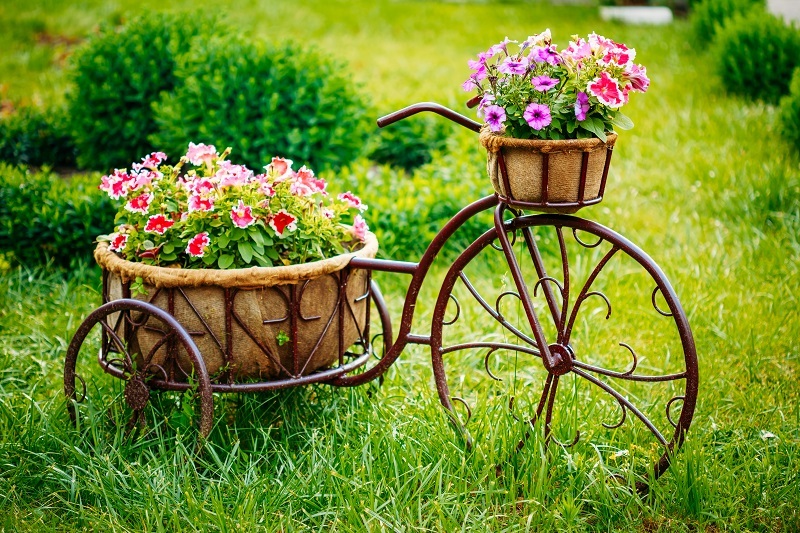Sunflowers Unveiled: 8 Unknown Facts That Intrigue
Posted on 17/08/2025
Sunflowers Unveiled: 8 Unknown Facts That Intrigue
Sunflowers (Helianthus annuus) have fascinated people for centuries, not just for their vibrant beauty but also for their many hidden wonders. These golden giants are far more complex and intriguing than their familiar appearance in gardens and fields may suggest. In this in-depth article, we reveal captivating facts about sunflowers you likely never knew, taking you deep into the science, history, and culture surrounding one of the world's most beloved blooms. Whether you are a gardening enthusiast, a curious learner, or simply an admirer of stunning flora, this is your complete guide to understanding sunflowers beyond the surface.
Discover the secrets behind their towering stalks and cheerful faces--prepare to be surprised!
1. The Sunflower's Face Isn't Just One Flower
When most people look at a sunflower, they see what appears to be a single, massive yellow flower. However, what you're actually seeing is a composite of hundreds, or even thousands, of small flowers called florets. Botanically, the sunflower's "face" is known as a capitulum, and it is composed of two types of florets:
- Ray florets: These are the bright yellow or gold "petals" that encircle the edge of the sunflower. Each "petal" is in fact an individual flower, but these are usually sterile and serve the purpose of attracting pollinators.
- Disk florets: Found in the central darker part of the sunflower's face, these tiny structures are actually hundreds or thousands of individual, fertile flowers that each can potentially turn into a seed.
Understanding this unique botanical feature is key to appreciating just how remarkable the sunflower plant truly is. Their ability to generate hundreds to thousands of seeds in a single head is just one reason they have become a symbol of prosperity and abundance across cultures.
Why Is This Important?
This "multi-flower" capability supports high rates of successful pollination, making the sunflower a favorite in agriculture for seed and oil production across the world.

2. Sunflower Faces Follow the Sun--But Only as Teens!
One of the most compelling unknown facts about sunflowers is their behavior known as heliotropism. Young sunflower plants exhibit a "dance" where their heads follow the movement of the sun from east to west during the day. This allows them to absorb maximum sunlight, fueling their rapid growth during their adolescence.
- Daytime: The young flower heads track the sun from sunrise (east) to sunset (west).
- Nighttime: They reset overnight back to the east, ready to greet the sunrise again.
However, as the sunflower matures and the bloom opens, heliotropism ceases, and the flower will almost always face east. Scientists believe this evolutionary adaptation helps attract more pollinators, as east-facing flowers warm up more quickly in the morning, luring early bees and other insects for pollination.
Fun Fact:
If you examine a field of mature sunflowers, you'll notice almost all the heads uniformly face east, making for breathtaking views and incredible photographs.
3. Sunflowers Help Clean Up Radioactive Soil
Few people realize that sunflower plants aren't just pretty--they're practical heroes in the fight against environmental pollution. Owing to a process called phytoremediation, sunflowers are capable of absorbing toxic substances, including heavy metals like lead, arsenic, and even radioactive isotopes from contaminated soil and water.
- After the 1986 Chernobyl nuclear disaster in Ukraine, sunflowers were planted to help extract radioactive cesium and strontium from the soil.
- Similarly, in Japan, sunflowers were used after the 2011 Fukushima nuclear accident to absorb radioactive substances and help restore the contaminated land.
Their unique root system and rapid growth allow sunflowers to accumulate and store dangerous substances, making them a natural, eco-friendly remedy for post-disaster land recovery.
4. Sunflowers Inspire Mathematical Marvels
Another astonishing unknown sunflower fact lies in their intricate mathematical design. The spirals at the heart of the sunflower display a pattern called Fibonacci sequence--where each number is the sum of the two preceding numbers (1, 1, 2, 3, 5, 8, etc.). The florets are typically arranged in two opposing spiral sets, and the number of spirals in each direction usually corresponds to two successive Fibonacci numbers.
- This arrangement allows the sunflower to pack the maximum possible number of seeds into a given seed head with perfect efficiency.
- It is also a topic of intrigue in fields like mathematics, botany, and computer science for its example of natural optimization.
The mesmerizing spiral pattern isn't just for show--it's mathematical genius in action!
Did You Know?
Because of this mathematical beauty, sunflowers have inspired artists, architects, and scientists alike throughout history. The pattern has been referenced in art, design, and even digital technology.
5. Sunflowers Have Been Cultivated for Over 4,500 Years
While sunflowers seem like a modern crop, their history is as rich as it is ancient. Native Americans first domesticated sunflowers in North America well over four millennia ago. They cultivated them for food, oil, and medicinal purposes long before European explorers arrived.
- Early Native American tribes used ground sunflower seeds to make flour for bread and cakes.
- Sunflower oil was utilized both for cooking and for healing wounds.
- The bright petals and seeds found their way into spiritual medicine, rituals, and as dye for textiles.
It wasn't until the 16th century that sunflowers made their way to Europe, where they quickly became popular not just as an ornamental flower, but also as a source for food oils and snacks, eventually spreading worldwide.
6. Giant Sunflowers Set Astonishing World Records
Sunflowers are not just eye-catching--they're record breakers! Some sunflowers reach truly colossal sizes, capturing global attention and making for jaw-dropping garden displays. The current official record for the tallest sunflower is 9.17 meters (30 feet 1 inch), grown by Hans-Peter Schiffer in Germany.
- Sunflowers can grow as little as 2 feet or as much as 15+ feet, depending on the variety.
- The "Russian Mammoth" and other giant variants are particularly renowned for their impressive heights and flower head sizes.
- Some sunflower heads have reached over 2 feet (61 cm) across--a sight to behold!
Records like these have led to friendly competitions among growers worldwide, with entire communities gathering each year to weigh and measure their giant blooms.
7. Sunflower Seeds: Tiny Nutritional Powerhouses
While the bright blooms get all the attention, sunflower seeds are unsung heroes in the world of healthy snacks. They are rich in Vitamin E, magnesium, selenium, protein, fiber, and healthy fats. Here's what makes these seeds so special:
- High in antioxidants: Sunflower seeds are a source of Vitamin E, an essential antioxidant for cellular repair and heart health.
- Heart-friendly: With unsaturated fats and plant compounds, sunflower seeds support cardiovascular wellness.
- Versatile food ingredient: Eaten raw, roasted, or added to salads and baking, sunflower seeds are a staple in cuisines around the globe.
- Source of plant protein: Popular among vegetarians and vegans for an easily-accessible, protein-rich food option.
Additionally, sunflower oil, extracted from seeds, is widely used for cooking due to its high smoke point and mild flavor profile.
Tip for Readers:
To maximize the benefits, opt for unsalted, unprocessed sunflower seeds and use sunflower oil in moderation within a varied diet.

8. More Than a Flower: Sunflowers in Art, Symbolism, and Culture
Finally, there is perhaps no flower as culturally resonant as the sunflower. Through centuries and across continents, sunflowers have been celebrated in art, literature, and spiritual traditions, embodying optimism, loyalty, and resilience.
- Vincent van Gogh's Sunflowers: The iconic series of paintings by the Dutch master made the sunflower an enduring symbol of creativity and warmth.
- Symbol of positivity: In folklore and modern culture, sunflowers represent the sun, happiness, and good luck.
- Political symbolism: The flower has been used to symbolize anti-nuclear movements, environmental awareness, and peace efforts worldwide.
For many, sunflowers are a living tribute to hope and endurance, growing tall and proud even under the harshest of conditions. They are a frequent motif in home decor, fashion, and social media, reminding people everywhere to keep their "faces to the sunshine."
Conclusion: The Secret Life of Sunflowers, Revealed
From their hidden multitude of flowers to their astonishing ability to cleanse the Earth and inspire mathematical awe, sunflowers are much more than meets the eye. These gorgeous giants are a combination of natural engineering, historical significance, and practical utility, making them one of the planet's most remarkable plants. The next time you walk past a row of sunflowers or enjoy a handful of sunflower seeds, remember their profound story--an interplay of nature, science, and human culture.
- Sunflowers unveil a world of wonder with each towering stem and spiral seed pattern.
- The more we learn about the Helianthus annuus, the more they intrigue and inspire.
Have you been surprised by any of these little-known sunflower facts? Share this article and start a conversation about nature's most captivating flowers!
Explore More on Sunflowers:
- National Geographic - Sunflower Facts
- Smithsonian Magazine - The Secret Behind Sunflower Beauty
- Gardener's World - How to Grow Sunflowers
Let the sunflower's bright face remind you of nature's many mysteries--unveiled, they offer lessons in growth, resilience, and joy.
Latest Posts
Best Flower Delivery Services Near [POSTCODE] in [AREA]
Floral Matchmaker: Finding the Perfect Petal for Your Personality
Sunflowers Unveiled: 8 Unknown Facts That Intrigue





